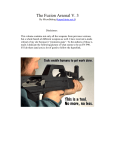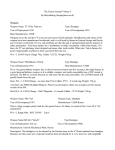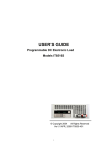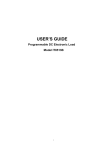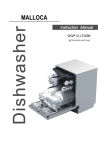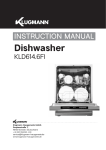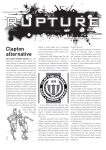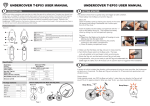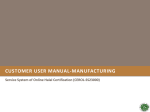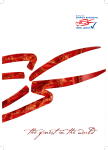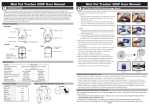Download English User`s Manual Welcome to Part One Chapter
Transcript
English User’s Manual Welcome to Part One Chapter One Words and their Work 1 Sounds that mean something and become words Different jobs for different words – parts of speech Words are the basic units of language with which we communicate. Sometimes a word is enough on its own: “Stop.“ Someone is telling you what to do. There might be a crash or simply an appearance before the local magistrates if you don’t, but stop you must. Just one word. A sentence 1-400 words Sometimes a lot more words are used in a sentence. Count the words in each sentence in the first paragraph, eleven, nine, seven, twenty, and three. No, the last three words in the paragraph do not form a sentence but I have made them look like one. I will explain later, but for now it’s important to realise that sentences can be very short, or ts of speech very long. One of the language’s longest sentences is to be found in Learning yourover language – listening readingfour James Joyce’s Ulysses. It’s just a page long and – about hundred words! I will return to sentences, clauses and phrases later. Now we must go back to basics, to words. Words – not just noises – but noises with an agreed meaning Words are sounds, or groups of sounds that enable us to mean things and to convey or communicate these meanings to other people. Some of our ancestors found that they could change and vary basic animal sounds so that we have far more sounds to use as signals. By stretching and twisting our mouths and our tongues we can form human or articulate speech. (Think of a bird’s eye view of an articulated lorry swerving sharply one way then another.) Try making simple animal sounds. You will find that most animal sound is represented by the five letters which we call vowels, a,e,i,o,u. A good one to try is the mooing of a cow. (The best way to imitate the 1 sound of a cow mooing is to open your mouth but let the sound come down your nose – most cows leave out the m.) 44 sounds 26 letters Then try reading this paragraph aloud, very slowly, very clearly and very carefully, like a television newsreader, or like someone who is trying to make a deaf person understand. Now you are also using, very carefully, the sounds represented by the remaining twenty-one letters of the alphabet. These letters represent the ways that we shape our mouths when we speak. These letters we call consonants – with the sound. They tell us how to shape our mouths as we make the sounds of our language. Try looking at your mouth in a mirror and watch closely, as you say “Tit,” “Bumble” then “Lilly.” Essentially, these twenty-six letters, our alphabet, enable us to write down the sounds of speech, to make a visual record of what we say. Written words – faster communication Brain – faster than mouth As you read this you are actually using a sophisticated system for converting visual signs into speech. Your brain reacts to these signs so quickly that you do not have time to speak them out loud, but you understand them as clearly as if you were listening to someone speaking aloud. Time yourself reading a page of a book silently, to yourself. You’ll probably take about a minute, possibly less. Then try reading it aloud. To do this you will take about three minutes, a speed of about one hundred words per minute. When Angela Ripon read the news on BBC television she had to be slowed down once her reading speed reached 120 words per minute. Up to that speed viewers could take in what she was telling them. When you read silently, you are taking in words three times as quickly, something we have only been able to do in English for about six hundred years although we have been writing in English for about fifteen hundred years. So, what you are doing now is incredibly clever - your brain can think much faster than your mouth can speak, and you can now begin to appreciate even more the importance of the written language; it enables us to take in information incredibly rapidly, it communicates despite the writer’s absence and it provides a record. Now we are back to your concern to use the written language as well as you can, and the basics. Words. Nouns – names of things Words join together in phrases or sentences to form language and carry meaning. Some words, like “pencil” have an obvious meaning – we can point to things like pencils and say the word and we have conveyed the idea even to someone who does not speak English. Similarly we can point to a sheep and teach the name for it, but how then would we teach someone the word “animal”? If the foreigner points at the sheep and says, “animal” we cannot shake our heads and tell him that he is wrong. That would be confusing for him; it’s not his fault that he doesn’t realize that we want him to use the word for this 2 particular animal, sheep. So, how are we going to teach both words so that our pupil learns to use both of them properly? Remember, the key thing is to set things up so that he cannot get things wrong. This is where you are now trying to stand outside our language, thinking about it in a different way, learning how it works. Finding answers to this sort of question is something that teachers enjoy, a challenge to the brain. If I was teaching on a farm or in a zoo it would be easy to show that all of the creatures there could be called animals but only particular animals, those with long snouts, big ears and curly tails, and called Percy, could be called pigs. One answer would be to use pictures, in a book, on a sketch pad or on a white board. You can probably think up ideas of your own and that way you will be getting outside your language. Sheep – a particular animal Animal – could be a horse or a sheep or a rabbit Just to be technical for a moment, animal here is a general word used to bring together several particular words such as goat and sheep. At another level, animal can be used as a particular word, along with bird and reptile, while we are using creature as a general word. Just as goats, pigs and sheep are all animals, so animals, reptiles and birds are all creatures. General words hold together groups of particular words. Brain hurting yet? Just think of all these animals running about in a classroom full of children. Not much teaching would get done. For that we need simple pictures of the animals and the names of the animals, labels, written underneath. What I’m trying to show you here is the range of jobs that words can do on their own before they start to operate with other words. So far we have dealt only one kind of nouns, the common noun. There are also proper nouns, collective nouns and abstract nouns. Common nouns nouns names things school teacher label Nouns are all names of things. I want you to imagine being at school, at the age of about twelve. A slightly mad young teacher has handed each of you some old-fashioned card luggage labels, the sort that has a hole at one end so that you can tie it to something. The teacher has been talking about nouns and naming or labelling things and asks you to write as many of the names of things in the room as you can, each on a separate label. When you have finished you are going to fasten the labels to the things to which they apply. The teacher has extra string, sellotape and blue-tack to help you with this. So, decide now, which nouns are you going to fix as labels on things that are in the room? This is where we find out whether you were trouble at school. The teacher walks around the class, looking at your choice of nouns. If you have written words like door, or desk or even student, that’s fine and you can fasten your labels onto something or someone straight away. However, if you have prepared labels for certain body parts located between the shoulders and the crutch, then you will be made to wait to one side with your labels. Later, your teacher will tell you to give up 3 the label to someone else in the class who will then label your private bits, rather than someone else’s, and you will have learnt that you are going to take notice of this teacher. Someone has written friend on his label, but no one wants to be his friend so the teacher gets the boy to give the label to one of the girls who finds another girl to stand still long enough for her to tie the label to her wrist, long enough to be her friend. Someone has written class. The teacher pauses for a moment, then reaches for the string and snips off a long, long piece. He gives it to the student who hands one end to another student who is standing at the edge of the room. While the others watch he walks around all of them, letting out the string as he goes. Back to the first student, he takes both ends of the string and pulls them as tightly as he can. Could this be you, the class joker? His victims wriggle and try to push each other onto the floor but they are tied together in a group, a class, and the joker is absolutely right with his label. It could have been one of the nerds, or perhaps some smart kid, wanting to catch out this new teacher, but it’s one of the girls this time. Her word is bored. She stands in front of the teacher all wriggle and pout and hands on her hips: “Sort this out then, clever clogs.” You can imagine her saying the words, but she doesn’t. The teacher takes her label and picks up a pencil. He changes the word – boredom. “That do?” he asks and the girl nods. “Charlie!” Charlie is one of nature’s artists – his cartoons appear in the school magazine, and other places when no one’s watching. “Charlie – can you help us out mate?” You remember teachers, always friendly when they want a favour. The teacher explains something to Charlie who gets to work on the large whiteboard. Soon there is another class of students in front of you, all of them slumped on their desks, ignoring a match-stick figure of a teacher who is talking on and on in front of them. Not one of them is taking any notice; one is patting his mouth in an obvious gesture to the teacher who ignores him. Your teacher hands back the girl’s altered label and she sticks it on the white board. Even someone who did not speak English would realise what was what. The word is like the label on a painting or a photograph and we know that it tells us about the idea that the picture or photograph suggests, not about the things that are in the picture. It depends on our understanding of what we can see, of knowing that bored people put their heads down and yawn. It’s an abstract idea, pulled away from the actual things that we can see. 4 Then the teacher tells the class to pick up one more blank label each and write their own name on them. When they have done this he collects them up, shuffles them and walks around the room, sticking them onto windows, walls and doors, turned so the names cannot be seen. Now the each student has to find his or her label and there is chaos for several moments. Eventually everyone has the right one. Some of them cling to their labels as if they are their personal property and refuse to show the others and the class realises that there is only one place for each label. “Each of you,” says the teacher, “has your own piece of property.” They are puzzled – so the school is giving away luggage labels - but they listen as he explains what proper nouns do – they name particular individuals, they label a particular sort of uniqueness. What has the teacher taught the class? What have you learned from this? There are four kinds of nouns. Common nouns refer to ordinary things such as mushrooms, stars and names. Collective nouns refer to groups of things: herds of cows, packs of wolves. Abstract nouns refer to our understandings of things: boredom, friendship, justice and pain. Proper nouns are like property; they belong to particular people, John Smith, or to particular places, New York for example. Exercise One Ask yourself how well you think you have followed things so far. If you complete this exercise you should feel confident and that will help you move along more quickly. You will find the answers towards the back of the book. When you check your answers the important thing to do is to ensure that you understand any errors you have made. i. Identify the nouns in these sentences and decide which type each one represents. a. Aeroplanes are expensive. b. Aeroplanes are expensive items. c. Fleets of aeroplanes are very expensive. d. British Airways’ shares are cheap. e. British Airways have been praised for their efficiency. ii. Still unsure? Test and teach yourself. Make your own list of nouns, decide in which category each one belongs then check with a dictionary. iii. Now try something a little more demanding. a. All cows eat grass. b. Teachers of music use this sentence as a mnemonic (pronounced 5 newmonic) to help their pupils remember the notes on lines of written music. c. Players in a band have to respond to melody, harmony and rhythm if they are to succeed. If they do this well the result can be great enjoyment; if not there is cacophony. [You should have found a total of 18 nouns in section iii, counting one noun twice.] By now I hope that you are getting the hang of my way of explaining things. We need to move on. We still have to examine seven more kinds of words – parts of speech, to be technical. Answers – Exercise One i. a. Aeroplanes (common) b. Aeroplanes, items (both common) c. fleets (collective), aeroplanes (common) d. British Airways (proper), shares (common) e. British Airways (proper), efficiency (abstract) iii. a. Cows (common), grass (common) b. Teachers, music, sentence, mnemonic, pupils, notes, lines, music (all common) c. Players, band, melody, harmony, rhythm, result, cacophony – all common except enjoyment which is abstract. Now, check that you understand any mistakes before celebrating your successes. Adjectives – words used to describe things Imagine a handful of pencils, green pencils and yellow pencils. The words yellow and green are used to describe the pencils. I am very fussy about this, old-fashioned even, so pay attention. The words yellow and green do not describe the pencils, or anything else come to that. These words are adjectives, used by human beings to describe things. In English, and other languages, only humans can describe things. If you get this wrong in future I will shout at you. Adjectives provide additional information about things – one of the pencils was yellow and another was green. Adjectives are said to qualify nouns, to tell us more about them; an intelligent horse, a kosher camel – no of course I haven’t checked – an incredible teacher. (Kosher is a Hebrew word. Jews use the word to indicate that something may be eaten according to their religious law. The Arabic word halal is used for the same purpose by Muslims.) A little complication now – there are always complications with our language – this and that, these and those. 6 In class I would point to one student and say something like, This boy at the front of the class and that boy at the back of the class may go home early. There would follow an argument about just which boys I meant for they would all want to go home early. The words this and that simply enable me to demonstrate exactly which boys are to go home early, just as yellow and green enabled me to indicate particular pencils. These and those are the plural forms of this and that: they are demonstrative adjectives. And a further complication; these four words can also function as pronouns to which we will come shortly. Exercise Two i. Identify the adjectives in these sentences. a. Tigers are impressive animals. b. They stacked the wooden chairs. c. Fleets of aeroplanes are very expensive. d. From the air they could see the grey water below them. e. His curly hair impressed the girl. Now try something a little more demanding. Each of these sentences contains more than one adjective. Some of them are not straightforward like matters of shape or colour. ii. Identify the adjectives in these sentences. a. The best aeroplanes are expensive. b. All the men helped to stack the wooden chairs. c. Future requirements for the military will be difficult to justify. d. Buy cheap; sell dear. e. British Airways have been praised for their efficiency. Answers – Exercise Two i. a. impressive b. wooden c. expensive d. grey e. curly ii. a. Best – a superlative – better than anything else. Expensive b. All – number – every one. Wooden c. Future, difficult d. Cheap, dear e. Praised, their – a possessive adjective which tells us whose efficiency is involved. Now, check that you understand any mistakes before celebrating your successes. Verbs – action words at the heart of a sentence 7 Odd one out – to be More like an equals sign = Do you remember “Stop”? When I ask students how many words you need to form a sentence the answers can be great fun. I rarely get the correct response, “One, one verb.” We can’t stop now but we do need at least to slow down while we deal with this very important kind of word, the verb. This is the word that tells us what is happening or has happened, or will happen. There is of course an exception here; the verb to be tells us something about the state of the world – Boys and girls are different - rather than about an action. You are about to be thrown in at the deep end. There is no other way, but then, I trust, you are capable, determined and learning fast. Tell me, can you try identifying the verbs in the previous paragraph that begins, “Do you remember....? There are sixteen of them. Here is the same paragraph with the verbs underlined. Do (you) remember “Stop”? When I ask kids how many words you need to form a sentence the answers can be great fun. I rarely get the correct response, “One, one verb.” We can’t stop now but we do need at least to slow down while we deal with this very important kind of word, the verb. This is the word that tells us what is happening or has happened, or will happen. There is of course an exception here; the verb to be tells us something about the state of the world, rather than about an action. There are three questions about verbs which should have revealed themselves by now. Grammatical action – I hope West Ham win. The infinitive – a verb’s name or title The first question concerns the grammatical sense of “action.” This does not simply mean some physical event that we can see or hear. It can also refer to a mental action, for example, when we think about something. The words, we do need at least to slow down from the last paragraph, show that I had thought about something, the speed with which I was presenting ideas to you. That was why I decided to slow down. My mind had been active. In grammar, the idea of an action is much wider and includes events that would not be thought of as action in the ordinary, common sense sort of way. The second question involves the “verbs” that follow the word to. To form and to slow. [Worry about down later.] These are very straightforward. They are the names of verbs, of actions. We call them infinitives and they are incomplete verbs, incomplete because there is no indication whether the action has already taken place, is taking place or will take place, and there is no indication of who or what it was that did the action. They are best regarded as the names of the verbs which are incomplete. [The word infinite is related to the French word fin which means end, and our word final – originally Latin, finis.] You knew this manual would be good value for money, didn’t you. French and Latin thrown in free as well as German! 8 Some of the verbs in the first paragraph of this section are single words, stop, ask, need, get, deals, is, tells, is, tells. Here is the same paragraph again with all the verbs emboldened. Do you remember “Stop”? When I ask students how many words you need to form a sentence the answers can be great fun. I rarely get the correct response, “One, one verb.” We can’t stop now but we do need at least to slow down while we deal with this very important kind of word, the verb. These are actions that happen and are no trouble to us; what happened? He or they or we stopped, asked, needed (something), was or whatever. The third question concerns the puzzle I left for you which comprises the verbs that are formed with more than one word, that appear in a phrase: do (you) remember, can be, can’t stop, do need, is happening, has happened, will happen. Here there is more than just the simple action. Compound verbs formed with auxiliary verbs Do is a verb in its own right – we do things. Combined with the word that tells us who or what is doing the action, in this case you, they form a question such as, “Do you like ice cream?” Another example, Can he swim? uses a different verb, the verb to be able – I can etc. In the case of has happened, the additional verb is the verb to have which marks a past tense – something that has taken place already. “She has texted him five times this morning and it’s only half-past seven.” These extra verbs are used as auxiliary verbs. (Auxilum – Latin for help or assistance) Auxiliary verbs, combined with an ordinary verb, form compound verbs e.g. was working, is trying and will succeed. Before we go on: my putting words in brackets, like (you) in the paragraph above – or underlining them or putting them in italics. These are my way of using the language at the same time that I am trying to analyse it. (If my wife ever reads this she will call it multitasking.) Exercise Three Here are a few sentences with compound verbs; identify the auxiliaries then ask yourself about the information or understanding that the word brings to the sentence. a. William was smiling. 9 b. c. d. e. They don’t smile here. He couldn’t wait. She might have waited. Can it be? Answers to Exercise Three a. Was – indicates a continuous action in the past b. Don’t (do not) – negates the verb – smiling is something they do not do c. Couldn’t (could not) – indicates an inability to do something in the past. He may be able to do it now. (Can you see how I have used a similar construction here to explain the answer? May indicates the possibility that he can wait now.) d. Can – indicates an ability in the present. Reversing the order of Can and it, the sentence is made into a question. If you enjoy this sort of thing, look for more compound verbs in newspapers, magazines and books. If you don’t, make sure that you understand this before you continue, even if that means re-reading the section on verbs or reading about verbs elsewhere. Sometimes another way of explaining something will do the trick. We are close to finishing work on this most important of words, the verb. Nothing happened is a sentence and, like all sentences, it depends on having a verb. In this case the verb is happened, which tells us what happened, grammatically, amongst the words, although, as we are told, nothing really did happen. What happened, grammatically, is that a statement was made, nothing happened and this statement told us that nothing had occurred or taken place. By next week I will have been enjoying ice cream for over fifty years. By the time you reach the end of this section you will have been studying several types of word. Tell me, how many auxiliary verbs did I use in the previous sentence? The answer is three; will and have indicate that the action of this verb studying will be complete at some time in the future and been, with working, rather than work alone, tells us that the action was continuous, that it will have been going on for some time by the time you reach the end of this section. This is the future past continuous tense. Yes, that’s quite right: future – will, past – have, continuous –been and the ing at the end of studying. We can say these things and we can write them down. With a bit of practice we will do so without thinking or worrying about it. This, I hope, is as difficult as things will get. 10 Elsewhere you will find this information about words set out in a systematic tabular way. In this chapter I am simply trying to show the different kinds of words that we use. The trouble is that words get mixed up with each other very quickly and, if we are not careful, we lose control of the damned things and we say things that we did not mean to say. This can be embarrassing or just plain annoying but it happens and we would like it to happen less often and that may well be why we are studying the language. My aunt’s neighbour once placed a small-ad in their local paper. Wanted Home for cross collie. Walks on lead. Clean. Easy to feed. A day or two later my aunt phoned her neighbour and said that she was from the RSPCA. Why, she demanded to know, why was the collie cross? Adverbs – describe actions and modify adjectives We are going to remove the adverb from the sentence that follows. Mr Blair resigned cheerfully. Now look again. Mr Blair resigned. Doubtless you could find replacements: hastily, sneakily, craftily, honourably. How do you study? Carefully? Determinedly? These adverbs could be used to qualify the verb resigned. (Remember qualify?) If you want to qualify the noun, Blair – what kind of noun? that’s right, a proper noun - you could qualify Blair with an adjective so that we would read, Cheerful/hasty/sneaky/crafty/honourable Mr Blair resigned. To concentrate on the man we use adjectives. To concentrate on the way he does things we use adverbs. The adverb, cheerfully, adds to what the verb tells us, that he resigned. Now we know how he resigned, cheerfully. Obviously the sort of people we are and the way we do things are linked, but we can choose to shift the emphasis from person to action. We could go further; Crafty Mr Blair resigned cheerfully, but one of Peter Brookes’ cartoons in The Times, following the Nantwich byelection in the spring of 2008, probably catches this much better – it shows New Labour as The Titanic, trying to re-launch itself from the ocean floor while Tony Blair, in the guise of a fish, swims away, grinning all the while. Slightly hurt Almost perfect There is another function that adverbs have, to modify adjectives 11 and other adverbs. I have italicised the adverbs in the next two sentences. “This shirt is clearly red,” my wife tells me; she thinks I’m colour blind. I put down the shirt very slowly and ask myself why I have agreed to go shopping with her. The shirt is not simply red, it is obviously red, or should be to anyone who is not blind or stupid and is clearly unsuitable, as my wife has tried to point out. (Here all three adverbs, simply, obviously and clearly are modifying the adjectives, red, and unsuitable.) Very and slowly are both adverbs. Slowly qualifies the verb put down; it tells us how I put down the shirt. Very is an unusual adverb – it is only used to modify adjectives and other adverbs. It functions as an intensifier; here it tells us how slowly indeed I put down the shirt, which I really liked. Ordinary adverbs also work like this, as modifiers. For example fairly in: Surely the shirt is not totally unsuitable for the colour will fade fairly quickly as I work out in the garden whenever I can. You should note that adverbs are often formed from adjectives; quick/quickly, charming/charmingly. In these and many other examples, the letters ly are added to the end of the adjective to form the adverb. Ending like this one are the remains of a link to the German word lich which means like. In both German and English the noun friend – German freund –becomes the adjective friendly or freundlich. Well done; the moment adverbs finished for. Exercise Four Identify the adverbs in these sentences and indicate what they qualify. a. b. c. d. e. f. g. She limped slowly along the road. Cautiously he approached his mother-in-law. It was cooked well. Fleets of aeroplanes are very expensive. He is almost completely bald. The teacher was barely breathing. The teacher was barely alive. Answers - Exercise Four a. b. c. d. e. Slowly – qualifies the verb limped Cautiously – qualifies the verb approached Well – qualifies the verb cooked Very – qualifies the adjective expensive Almost – qualifies the adverb completely - which qualifies the adjective bald 12 f. g. Barely – qualifies the verb was breathing Barely – qualifies the adjective alive Note how sentences f. and g. seem to say almost the same thing. For our purposes it is important to see how the language can be used like this. In the first sentence our attention is directed towards the lack of breathing, perhaps as a nurse or a doctor might observe a patient. In the second sentence the writer might be anticipating a death or arguments about the teacher’s will. There remain: pronouns, prepositions, conjunctions, articles, exclamations and things that sound like words. As we shall see in the next chapter, where there will be a sort of fancy-dress party for words, all these different kinds of words have their jobs to do. For the moment I am simply going to identify them as quickly and as easily as possible. Pronouns – stand in for nouns Mummy took away Billy’s ice cream. He cried. One day she would die. He and she are pronouns. They stand for nouns. (pro Latin - for or on behalf of) Without pronouns speech would be very laborious – try reading the next sentence aloud. Mummy took away Billy’s ice cream. Billy cried. One day Mummy would die. The thought cheered up Billy no end and Billy hoped that Mummy would get rich first so Billy would have all Mummy’s money when eventually Mummy died. One of the reasons that this sounds like baby talk is that children learn more slowly about pronouns and continue to use ordinary nouns, especially proper nouns, until they have done so. Even with pronouns where we would normally find them this little piece still sounds a bit creepy – Roald Dahl comes to mind – but it is now an adult voice, even if it has put some troubling ideas into a young man’s head. Try reading it again. Mummy, Billy – proper nouns He, she, him, I, me, my, mine, you, yours – pronouns Mummy took away Billy’s ice cream. He cried. One day she would die. The thought cheered him up no end and he hoped that she would get rich first so he would have all her money when eventually she died. That’s it really. I, me, my and mine are words that we all use in reference to ourselves when we do things, when things are done to us, when we refer to something that belongs to us. You can imagine a mad teacher who has an ice-cream fetish: 13 I like ice cream. Give me one and I will probably let you finish early. Yes, that’s my ice cream, not yours. Yes and all those are mine too. Exercise Five. Besides the six italicised pronouns in the above sentence, there are four others. Can you identify them? Remember they all stand for something or someone. Answer to Exercise Five The additional pronouns are: one (also functions as a noun and as an adjective), you, that (in that’s) and those. That and those both refer to ice-creams. Earlier we met the four demonstrative adjectives, this, that, these and those. We talked about this boy and that boy. Now look at another way of using these words. That’s the one I’d like. Automatically, we look for someone to point at something, to indicate which bunch of flowers, or picture or ice cream that has been chosen. These four words function as pronouns, standing in for a noun, but also enabling us to demonstrate which particular one we are talking about. This ice cream is delicious; this is rubbish. This ice cream is delicious. [Demonstrative adjective] This is rubbish. [Demonstrative pronoun] Coupled with a noun, these words are demonstrative adjectives; alone, they are demonstrative pronouns. Then how about: Words to form questions – who, whom, whose, which, what Who won the prize? The woman who cooked the best pizza. When we ask the question, Who won the prize? we need a word that stands in for someone we don’t know. The word who does just that. Here it functions as an interrogative pronoun. Other words can function in this way: whom, whose, which and what. e.g. Whose watch is this? (Tracey’s) Whom do you prefer? (Kerry) Many people just say, Who do you prefer? What do you want? (An ice cream) Which one? (The vanilla please) A reminder; we are examining our language to see how the components, words, work together. Now we must move on and see what Billy is up to. I wonder how Mummy’s getting on. Read this: Billy remembered the moment when Mummy took away his ice cream. She was found dead behind the nursery where she had left 14 him. Her body was discovered by his best friend who had seen the Kalashnikov which Billy had hidden in the push-chair. Billy’s probation officer, whom he had attacked with an ice lolly only the previous week, came, smiling, to take him away. Some questions What are we told about: The moment Billy remembered The nursery His best friend The Kalashinikov Billy’s probation officer Now try removing this information from the passage. Billy remembered the moment (when Mummy took away his ice cream). She was found dead behind the nursery (where she had left him). Her body was discovered by his best friend (who had seen the Kalashnikov) (which Billy had hidden in the push-chair). Billy’s probation officer, (whom he had attacked with an ice lolly only the previous week,) came, smiling, to take him away. And you are left with: Billy remembered the moment. She was found dead behind the nursery. Her body was discovered by his best friend. Billy’s probation officer came, smiling, to take him away. All the pieces of additional information, which I have now removed from the passage, are related to the main part of each sentence. They are joined by relative pronouns: when, where, who, which and whom. These words are acting just like components in an engine. They bring together bits of our language and enable it to work more efficiently. Without them this is what we would have to struggle to read: Billy remembered the moment. Mummy took away his ice cream at that moment. She was found dead behind the nursery. She had left him at the nursery. Her body was discovered by his best friend. His best friend had seen the Kalashnikov. Billy had hidden the Kalashnikov in the push-chair. Billy’s probation officer came, smiling, to take him away. Billy had attacked him with an ice lolly only the previous week. Now we are due in court. “Is this the gun that you found in the push chair?” The judge nodded at the Kalashnikov which the usher had placed on a table in front of the witness-box. The Kalashnikov, which had required three officers and two traffic wardens to wrestle it from Billy’s grasp, lay there in front of a packed court room. 15 That can also function as a relative pronoun. Here it relates the hidden gun to the push chair. This is important for the prosecution will need to link the two. It is not any gun, it is that particular one. Which, on the other hand, makes less important connections; the Kalashnikov happens to be on the table and it happened to require five men to take it away from Billy. What is important is that it was the gun that was found in the push chair. We will deal more thoroughly with the effects of using words in particular ways in a later chapter. Prepositions – link things and actions Well, start by thinking about position. What position are you in? Sitting probably, but on something, a chair, a settee, perhaps a table or a bed, or standing perhaps, in a bookshop or at a bus stop. There may be someone sitting next to you, or beside you and the lamp above you may be a good one, but not as good as the one which is throwing light through the doorway, over there where your friend is leaning against the wall waiting for you to go down to the pub. You would not have been through the chair, but you might have been in the bed and possibly spread along the settee. You might even have been under the table. Let’s start now by applying the Inson technique to this last sentence and remove one word, under. You might even have been the table. Off the table – not for discussion On the table – an offer Under the table drunk This sentence makes sense, but only grammatically. We know of course that you could never really be a table, so for the sentence to make practical sense another word is needed, a word such as above. This word, or others like it, under, next to, (a phrase that functions as a preposition) by, opposite, would all make sense. They are prepositions which tell us about the position of things, on the table, behind the door and so on. These prepositions link two nouns or pronouns; we saw him on the bike. Other prepositions tell us about movement. The lamp which was throwing light through the doorway. (It could have been past the doorway.) Instead of location, this type of preposition tells us about movement, about direction: along, up, down, towards. These prepositions link verbs, in this case was throwing, with nouns or pronouns, in this case, the doorway. (An aside here for you clever nerds who like to ask awkward questions. No, the preposition through does not link light and the doorway. “Right,” you say, “Tell us just what job the word light does do here?” 16 For a moment I pause, not because I haven’t got the answer right up my sleeve, but because I am a kind teacher and, just for a second or two, I will allow you to think that you have caught me out. But you haven’t. The word light tells me what the lamp was throwing. Light is the object of the verb was throwing and the lamp is the subject of the verb, and this should be enough to shut you up until we encounter these terms again in a later chapter. Now the rest of you can pay attention again so that we can finish prepositions. Walk into the swimming baths, from the bus stop, and swim in the pool once you get there. What is the difference between falling in the shower and falling into the shower? Could the shower door remain closed in both cases? How would you get Charlie, the class cartoonist, to draw each scenario? In is a preposition of location while into is a preposition of direction or movement so falling in the shower is possible without the door being opened whereas the door would have to be open if someone was going to fall into the shower, for the movement, the fall, would have to begin outside the shower and finish inside. I am assuming here that there is some sort of roof or top to the shower. If this is beginning to sound like something from a detective novel it might just be that words and the ways that we use them can be a very important matter. “May it please Your Honour.” Counsel for the defence was not having an easy day. He let his hands rest on (preposition of location) the table in front of him and turned his gaze towards (preposition of movement) the defendant. “The evidence put before you shows quite conclusively that the door of the shower had jammed and that the deceased’s fall took place inside (preposition of location) the shower. I put it to Your Honour that the accused could not have pushed the deceased into (preposition of movement) the shower even had he wanted to.” I could go on. But I won’t. It’s nearly time for an adjournment – a pause. I once dreamt about ice cream. What did my dream concern? It was about ice cream. About links the verb, dreamt with the noun ice cream. This is clearly nothing to do with position or movement but with something more abstract, about ideas and understanding, rather like abstract nouns. That’s it. Now I will adjourn to the garden while you complete the following.... Exercise Six Try identifying all the prepositions in this paragraph, which you have already met, and decide which type they are. Prepositions, well, start by thinking about position. What position are you in? Sitting probably, but on something, a chair, a settee, perhaps a table or a bed, or standing perhaps, in a bookshop or at a bus stop. There may be someone sitting 17 next to you, or beside you and the lamp above you may be a good one, but not as good as the one which is throwing light through the doorway, over there where your friend is leaning against the wall waiting for you to go down the road to the pub. Answers to Exercise Six about in on in at next to beside above through over against down to links the verb thinking with the noun position links the verb are with the noun position links the pronoun you (implied, from the previous sentence) to the pronoun something links you (the same you) to bookshop links you to bus stop links you to sitting links you to sitting links lamp to you links the verb is throwing with the noun doorway links the lamp which is throwing light – with the pronoun there - the place where your friend is leaning links is leaning with the wall links to go with the road (Here, think of down as meaning along.) links to go with the pub Now, check that you understand any mistakes before celebrating your successes. Next we have: Conjunctions – join words and groups of words Try reading this next paragraph aloud. I dreamt once that ice cream tasted of fried tomatoes. This had a devastating effect on me. For months afterwards I was unable to eat the stuff. Eventually I had to force myself to buy an ice cream to break the dream. Then I returned enthusiastically to Rossi’s ice cream parlour. Rossi’s had been my favourite maker of ice cream for years. We can improve things: I dreamt once that ice cream tasted of fried tomatoes and this had a devastating effect on me. For months afterwards I was unable to eat the stuff so, eventually, I had to force myself to buy an ice cream to break the dream. Then I returned enthusiastically to Rossi’s ice cream parlour because Rossi’s had been my favourite for years and I no longer dreaded eating ice cream. 18 Three words, and, so and because make this passage easier to read. The first two sentences are simple statements of fact and we can absorb them more quickly once they are linked by and, and we no longer have to pause after the word tomatoes. So links two sentences in which the action in the second sentence follows from the (grammatical) action in the first. In the third pair, because links the action in the first part of the sentence with the reason for that action, which we find in the second part of the sentence; because Rossi’s had been my favourite ice cream parlour I had returned there. In this example, separate sentences, which stand alone at first, are combined. Just remember that and is also used to join the last two items in a list. As we read, it signals the end of the list and we are ready to stop. Read the rest of this sentence aloud; so far we have tackled nouns, adjectives, adverbs, verbs, pronouns, prepositions and conjunctions. Conjunctions done. Articles – so easy that other languages don’t bother with them We have touched already on the business of articles in the introduction so all we have to do now is make sure that we have dealt with all four of them: a, an, some and the. Articles precede nouns to indicate whether particular things are being referred to or not. I am afraid that you are due in court again. A court official holds up a large, old-fashioned feather duster. “Is this,” asks the judge, “is this the feather duster you kept at home and which the prosecution claim was used by you to attack the prime minister?” You are relieved for it is simply a feather duster and not your old feather duster which had a green handle, not a red one, and you explain that the feather duster which you kept under the stairs at your home was destroyed at a fancy dress party weeks before the alleged attack. Wonderful – you’re not guilty. They can’t touch you. As the judge dismisses the case some police officers enter the court. That’s all right – they’re just coppers. Then you notice that among them are the officers whom you attacked with a banana the night you were arrested in Downing Street. The, the definite article which refers to particular things, the feather duster with the red or green handle, or the particular police officers whom you did not want to meet again. 19 The indefinite articles: a indicates here to any feather duster which is not yours and some to any police officers who were not attacked by you when you were armed with a banana in Downing Street. [An is simply used instead of a when the word that follows begins with one of the five vowels. Try saying a orange. The word comes from the Spanish, naranja, so perhaps we should say, a norange. You can imagine somebody in the market: “Lovely noranges. Four for a quid!”] For you it was important to convince the court that the feather duster shown in evidence was not the feather duster which lived under your stairs. As you leave the court you will probably take care to avoid any police officers, especially the officers whom you met in Downing Street that night. Case dismissed. Finally – Exclamations, interjections and swear words – reactions to things Exclamations, interjections, things that sound like words and anything else that occurs to me before we get to the end of this chapter. But first there follows a GOVERNMENT HEALTH WARNING This section contains words and expressions that we often hear and see but which some of us dislike. They are part of the language even if we only notice them, uncontrolled, in public places. It is a fact that some people express themselves excessively in language which other people find coarse or foul, or blasphemous, but these are words and the way they are used needs to be understood as part of an examination of our language. To do this we need to refer to these words, even if we do not use them. Think of them clinically, like a disease if you like, that we need to study however unpleasant it may be. “Oh shit!” You have stepped backwards into the wet concrete that you have just laid and staggered all over it. The footprints that you have left behind 20 laugh at you and so do your mates. Or, you have just realised that you have left the keys inside the car which you locked before you shut the rear door. Sometimes it is different, quicker. “Shit!” An own goal in extra time, or the slipping of a sharp knife in the kitchen. Links between words and meanings are not always fixed, and a dictionary will tell of shit’s basic meaning - excrement. (Poo in baby vocabulary or turds if you don’t want to sound posh) The word shit is more often met in speech, where there is greater flexibility, rather than in writing. In speech it is rarely used to stand for excrement. “Look at all that shit.” Here the word is obviously a noun, standing for something, but what? A pile of manure, a place full of rubbish or anything or anyone that we don’t like? Then try: “That was a shit goal.” A sports fan suffers disappointment and uses the word as a sort of adjective, but it tells us little about the goal, whether it was easy, or impressive. All we know is that for some reason that is not clear to us, the speaker was not impressed with this goal. “Oh shit! They missed.” Here the word is nothing to do with them or what they missed; it’s simply a reaction to the fact that they missed. Like indeed, damn, really, or God, the word has a meaning, something to which it refers. Later I will return to the origin and influence of words such as these. But for the moment it is sufficient to recognise that here they are simply used as a reaction to something and we call them exclamations, words that are called out in reaction to something. [Latin: ex = out and clamo = I call. Our modern clamour = a lot of calling out.] Interjections are sounds or words that are thrown in between “real” words. Imagine that you are in very serious trouble. You are very young and very keen not to be caught out. This could so easily have been two of us at school, playing firemen in the boys’ toilet which had no roof, at the age of five. Soon we found ourselves outside the headmistress’s office while she spoke to an angry woman who had been showered as she walked along the pavement outside. You struggle to explain and there is a loud, Hmmmm, from one of the adults and you realise that you are simply digging yourself in deeper. 21 (Hmmmm here is a warning that someone does not believe you and that you might as well own up straight away and save everyone a lot of time.) Er, a good one for really awkward questions and direct accusations, Oooh, for a large bill and a really well-timed coughing fit can of course bring a difficult conversation to a complete halt. So far, so good. Parts of speech – try to remember: Nouns name things Adjectives qualify nouns Verbs indicate the “action,” the heart of a sentence Adverbs qualify verbs and adjectives Pronouns stand in for nouns Prepositions link nouns, or nouns and verbs Conjunctions join words and groups of words Articles make clear the identity of things. There are also interjections and swear words and we will return to them later with oaths as well. Well done. Next – words in groups. How words work together 22























